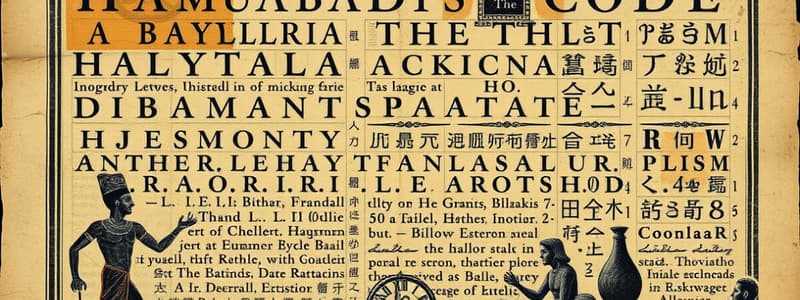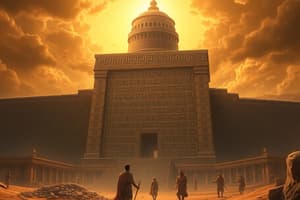Podcast
Questions and Answers
How many centuries did Hammurabi live?
How many centuries did Hammurabi live?
40
How long did Hammurabi rule?
How long did Hammurabi rule?
42 years
From Larsa to Mari, what was the approximate length of Babylonia from north to south?
From Larsa to Mari, what was the approximate length of Babylonia from north to south?
350 miles
What was the estimated population of Babylonia?
What was the estimated population of Babylonia?
Into what three social classes was the population divided?
Into what three social classes was the population divided?
How many laws were in Hammurabi's code?
How many laws were in Hammurabi's code?
Define city-state.
Define city-state.
What is Babylonia?
What is Babylonia?
What is Mesopotamia?
What is Mesopotamia?
What are the two rivers that are around Mesopotamia?
What are the two rivers that are around Mesopotamia?
What is cuneiform?
What is cuneiform?
What is a stele?
What is a stele?
What kind of writing was used to inscribe the code on the stele?
What kind of writing was used to inscribe the code on the stele?
The code is divided into what three parts?
The code is divided into what three parts?
From whom does Hammurabi get the laws?
From whom does Hammurabi get the laws?
Where did Shamash sit while giving Hammurabi the laws?
Where did Shamash sit while giving Hammurabi the laws?
What was the purpose of having written these laws?
What was the purpose of having written these laws?
Who commanded Hammurabi to create this monument?
Who commanded Hammurabi to create this monument?
What does Hammurabi threaten will happen to any future Babylonian king who does not follow these laws?
What does Hammurabi threaten will happen to any future Babylonian king who does not follow these laws?
In Law 129, what does it mean to 'bind them and cast them into water'?
In Law 129, what does it mean to 'bind them and cast them into water'?
In Law 168, what does it mean to 'disinherit' a son?
In Law 168, what does it mean to 'disinherit' a son?
In Law 21, what is the penalty for breaking into a home?
In Law 21, what is the penalty for breaking into a home?
In Law 23, if the robber is not caught, who reimburses the victim for his or her loss?
In Law 23, if the robber is not caught, who reimburses the victim for his or her loss?
In Law 48, what is a creditor?
In Law 48, what is a creditor?
What is the meaning of 'fruit of her womb'?
What is the meaning of 'fruit of her womb'?
Flashcards are hidden until you start studying
Study Notes
Hammurabi's Code Overview
- Hammurabi lived for approximately 40 centuries ago.
- He ruled Babylonia for 42 years.
- The length of Babylonia from Larsa to Mari was about 350 miles.
- Babylonia had an estimated population of one million inhabitants.
Social Structure
- The society was divided into three classes: landowners, free non-landowners, and slaves.
Hammurabi's Code
- Hammurabi's code consisted of 282 distinct laws.
- The laws are categorized into procedural law, property law, and the law of persons.
- The code was inscribed in wedge-shaped cuneiform on a stele, a carved stone slab.
Geography and Culture
- Babylonia was part of an ancient Mesopotamian empire located in the Fertile Crescent during the 1700s B.C.
- Mesopotamia refers to the land situated between the Tigris and Euphrates rivers.
Writing and Legal Procedures
- Cuneiform writing, characterized by its wedge shapes, was used for documentation.
- Shamash, the sun god, was believed to have bestowed the laws upon Hammurabi while seated on a throne.
- The purpose of the laws was to protect the weak and ensure justice.
Divine Authority and Penalties
- Shamash commanded Hammurabi to establish these legal codes.
- Future Babylonian kings failing to adhere to these laws would face curses upon their families and land.
Specific Laws and Their Implications
- Law 129 involved the punishment of drowning for adultery, binding the guilty parties together.
- Law 168 allowed for the disinheritance of sons, severing legal ties.
- Law 21 prescribed death as punishment for burglary.
- If a robber remained uncaught, law 23 mandated reimbursement by the mayor and city.
- Law 48 defined a creditor as the individual from whom money was borrowed.
- The term "fruit of her womb" refers to an unborn baby.
Studying That Suits You
Use AI to generate personalized quizzes and flashcards to suit your learning preferences.





